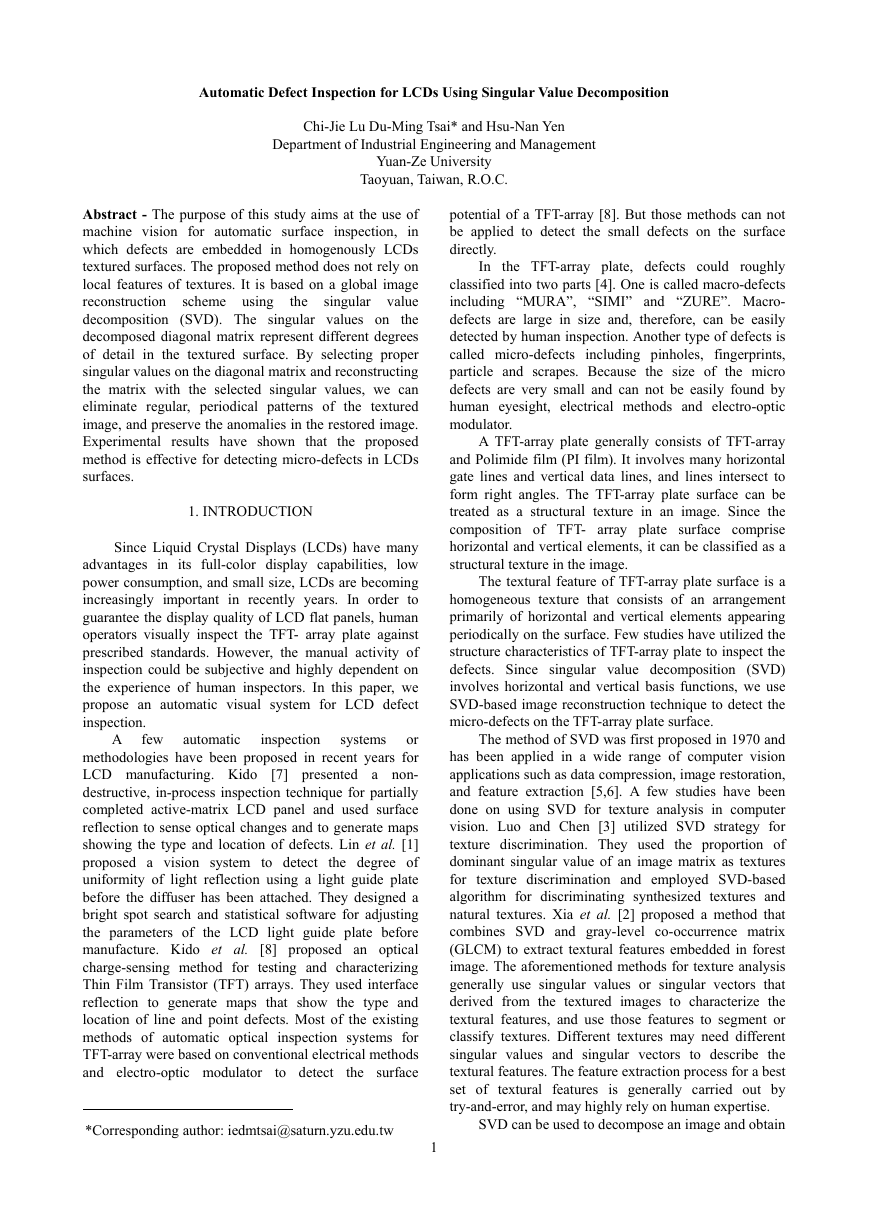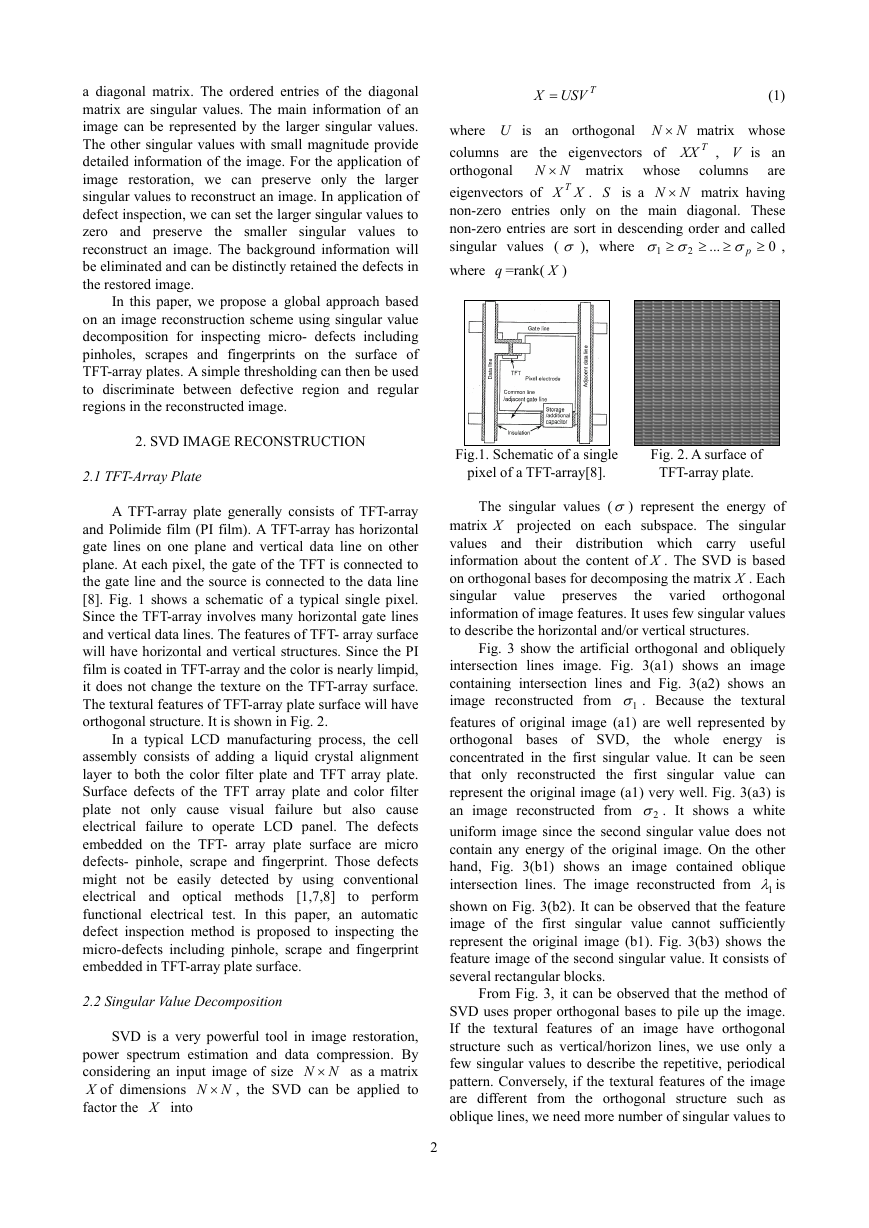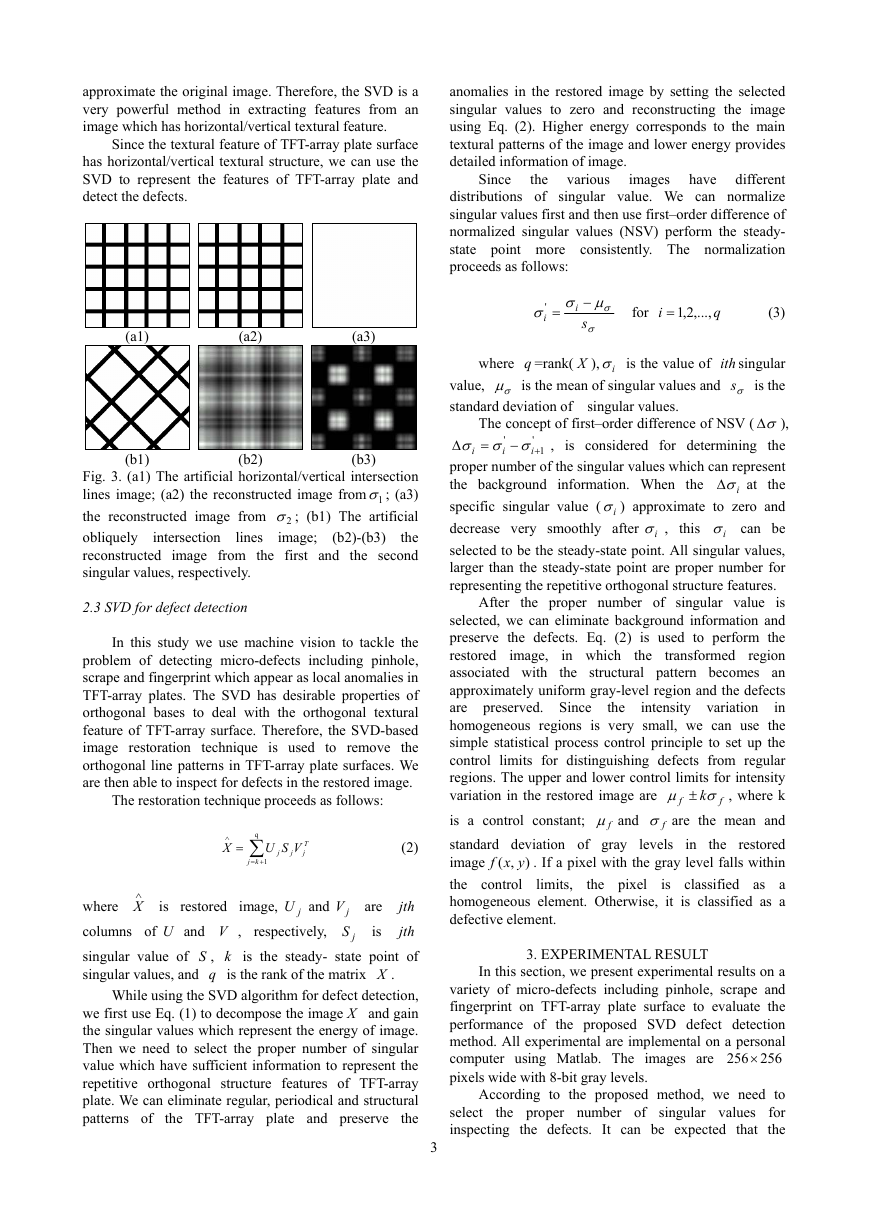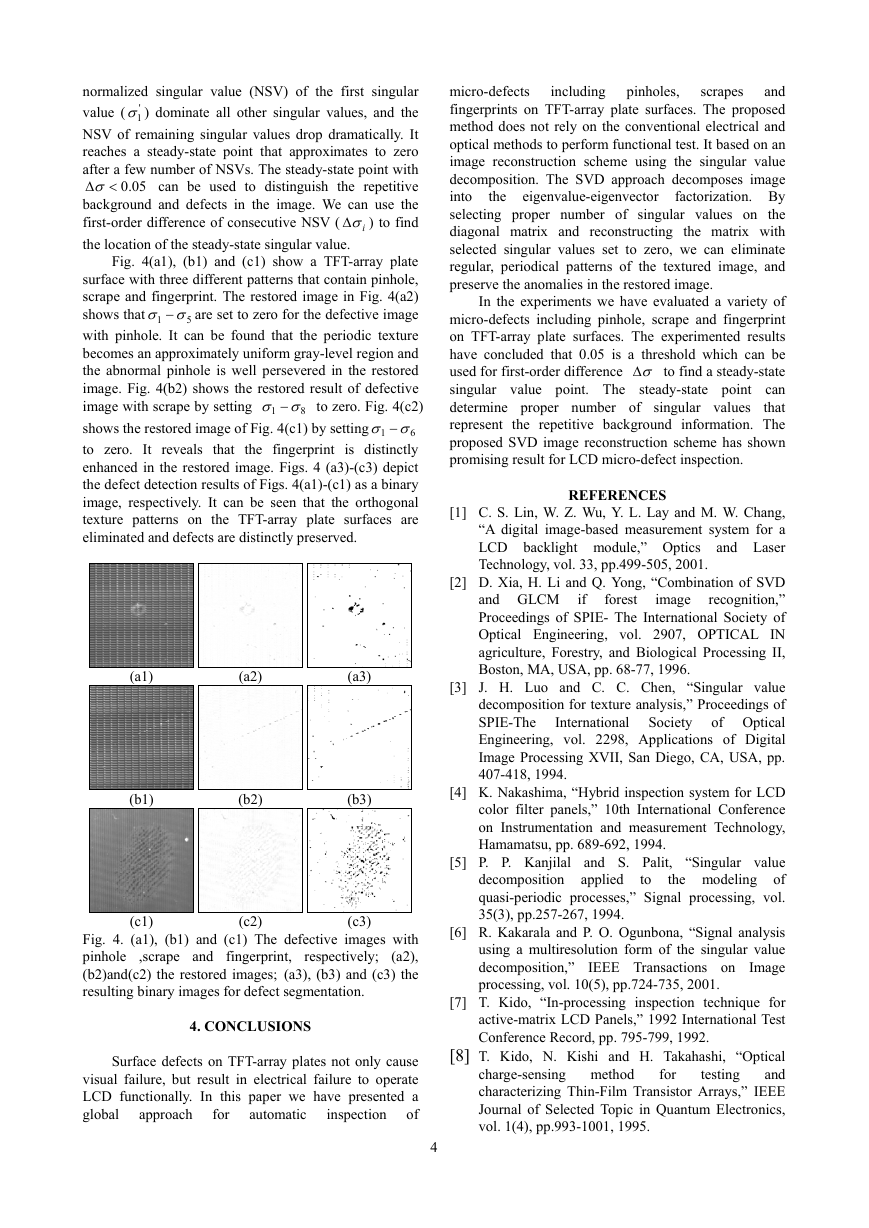Automatic Defect Inspection for LCDs Using Singular Value Decomposition
Chi-Jie Lu Du-Ming Tsai* and Hsu-Nan Yen
Department of Industrial Engineering and Management
Yuan-Ze University
Taoyuan, Taiwan, R.O.C.
the
scheme using
Abstract - The purpose of this study aims at the use of
machine vision for automatic surface inspection, in
which defects are embedded in homogenously LCDs
textured surfaces. The proposed method does not rely on
local features of textures. It is based on a global image
reconstruction
singular value
decomposition (SVD). The singular values on the
decomposed diagonal matrix represent different degrees
of detail in the textured surface. By selecting proper
singular values on the diagonal matrix and reconstructing
the matrix with the selected singular values, we can
eliminate regular, periodical patterns of the textured
image, and preserve the anomalies in the restored image.
Experimental results have shown that the proposed
method is effective for detecting micro-defects in LCDs
surfaces.
1. INTRODUCTION
A
few
Since Liquid Crystal Displays (LCDs) have many
advantages in its full-color display capabilities, low
power consumption, and small size, LCDs are becoming
increasingly important in recently years. In order to
guarantee the display quality of LCD flat panels, human
operators visually inspect the TFT- array plate against
prescribed standards. However, the manual activity of
inspection could be subjective and highly dependent on
the experience of human inspectors. In this paper, we
propose an automatic visual system for LCD defect
inspection.
systems
automatic
inspection
or
methodologies have been proposed in recent years for
LCD manufacturing. Kido
[7] presented a non-
destructive, in-process inspection technique for partially
completed active-matrix LCD panel and used surface
reflection to sense optical changes and to generate maps
showing the type and location of defects. Lin et al. [1]
proposed a vision system to detect the degree of
uniformity of light reflection using a light guide plate
before the diffuser has been attached. They designed a
bright spot search and statistical software for adjusting
the parameters of the LCD light guide plate before
manufacture. Kido et al. [8] proposed an optical
charge-sensing method for testing and characterizing
Thin Film Transistor (TFT) arrays. They used interface
reflection to generate maps that show the type and
location of line and point defects. Most of the existing
methods of automatic optical inspection systems for
TFT-array were based on conventional electrical methods
and electro-optic modulator
the surface
to detect
potential of a TFT-array [8]. But those methods can not
be applied to detect the small defects on the surface
directly.
In the TFT-array plate, defects could roughly
classified into two parts [4]. One is called macro-defects
including “MURA”, “SIMI” and “ZURE”. Macro-
defects are large in size and, therefore, can be easily
detected by human inspection. Another type of defects is
called micro-defects including pinholes, fingerprints,
particle and scrapes. Because the size of the micro
defects are very small and can not be easily found by
human eyesight, electrical methods and electro-optic
modulator.
A TFT-array plate generally consists of TFT-array
and Polimide film (PI film). It involves many horizontal
gate lines and vertical data lines, and lines intersect to
form right angles. The TFT-array plate surface can be
treated as a structural texture in an image. Since the
composition of TFT- array plate surface comprise
horizontal and vertical elements, it can be classified as a
structural texture in the image.
The textural feature of TFT-array plate surface is a
homogeneous texture that consists of an arrangement
primarily of horizontal and vertical elements appearing
periodically on the surface. Few studies have utilized the
structure characteristics of TFT-array plate to inspect the
defects. Since singular value decomposition (SVD)
involves horizontal and vertical basis functions, we use
SVD-based image reconstruction technique to detect the
micro-defects on the TFT-array plate surface.
The method of SVD was first proposed in 1970 and
has been applied in a wide range of computer vision
applications such as data compression, image restoration,
and feature extraction [5,6]. A few studies have been
done on using SVD for texture analysis in computer
vision. Luo and Chen [3] utilized SVD strategy for
texture discrimination. They used the proportion of
dominant singular value of an image matrix as textures
for texture discrimination and employed SVD-based
algorithm for discriminating synthesized textures and
natural textures. Xia et al. [2] proposed a method that
combines SVD and gray-level co-occurrence matrix
(GLCM) to extract textural features embedded in forest
image. The aforementioned methods for texture analysis
generally use singular values or singular vectors that
derived from the textured images to characterize the
textural features, and use those features to segment or
classify textures. Different textures may need different
singular values and singular vectors to describe the
textural features. The feature extraction process for a best
set of textural features is generally carried out by
try-and-error, and may highly rely on human expertise.
SVD can be used to decompose an image and obtain
*Corresponding author: iedmtsai@saturn.yzu.edu.tw
1
�
a diagonal matrix. The ordered entries of the diagonal
matrix are singular values. The main information of an
image can be represented by the larger singular values.
The other singular values with small magnitude provide
detailed information of the image. For the application of
image restoration, we can preserve only the larger
singular values to reconstruct an image. In application of
defect inspection, we can set the larger singular values to
zero and preserve
to
reconstruct an image. The background information will
be eliminated and can be distinctly retained the defects in
the restored image.
the smaller singular values
In this paper, we propose a global approach based
on an image reconstruction scheme using singular value
decomposition for inspecting micro- defects including
pinholes, scrapes and fingerprints on the surface of
TFT-array plates. A simple thresholding can then be used
to discriminate between defective region and regular
regions in the reconstructed image.
2. SVD IMAGE RECONSTRUCTION
2.1 TFT-Array Plate
A TFT-array plate generally consists of TFT-array
and Polimide film (PI film). A TFT-array has horizontal
gate lines on one plane and vertical data line on other
plane. At each pixel, the gate of the TFT is connected to
the gate line and the source is connected to the data line
[8]. Fig. 1 shows a schematic of a typical single pixel.
Since the TFT-array involves many horizontal gate lines
and vertical data lines. The features of TFT- array surface
will have horizontal and vertical structures. Since the PI
film is coated in TFT-array and the color is nearly limpid,
it does not change the texture on the TFT-array surface.
The textural features of TFT-array plate surface will have
orthogonal structure. It is shown in Fig. 2.
In a typical LCD manufacturing process, the cell
assembly consists of adding a liquid crystal alignment
layer to both the color filter plate and TFT array plate.
Surface defects of the TFT array plate and color filter
plate not only cause visual failure but also cause
electrical failure to operate LCD panel. The defects
embedded on the TFT- array plate surface are micro
defects- pinhole, scrape and fingerprint. Those defects
might not be easily detected by using conventional
electrical and optical methods [1,7,8]
to perform
functional electrical test. In this paper, an automatic
defect inspection method is proposed to inspecting the
micro-defects including pinhole, scrape and fingerprint
embedded in TFT-array plate surface.
2.2 Singular Value Decomposition
SVD is a very powerful tool in image restoration,
power spectrum estimation and data compression. By
considering an input image of size
as a matrix
X of dimensions
, the SVD can be applied to
factor the X into
NN ×
NN ×
2
X =
TUSV
(1)
NN ×
NN ×
where U is an orthogonal
matrix whose
TXX , V is an
columns are the eigenvectors of
orthogonal
columns
are
eigenvectors of
matrix having
non-zero entries only on the main diagonal. These
non-zero entries are sort in descending order and called
singular values ( σ ), where
,
where q =rank( X )
matrix whose
. S is a
NN ×
σσ
2
XX T
pσ
≥
...
≥
≥
0
≥
1
Fig.1. Schematic of a single
pixel of a TFT-array[8].
Fig. 2. A surface of
TFT-array plate.
The singular values (σ) represent the energy of
matrix X projected on each subspace. The singular
values and
their distribution which carry useful
information about the content of X . The SVD is based
on orthogonal bases for decomposing the matrix X . Each
singular value preserves
the varied orthogonal
information of image features. It uses few singular values
to describe the horizontal and/or vertical structures.
the whole energy
Fig. 3 show the artificial orthogonal and obliquely
intersection lines image. Fig. 3(a1) shows an image
containing intersection lines and Fig. 3(a2) shows an
image reconstructed from
1σ . Because the textural
features of original image (a1) are well represented by
orthogonal bases of SVD,
is
concentrated in the first singular value. It can be seen
that only reconstructed the first singular value can
represent the original image (a1) very well. Fig. 3(a3) is
an image reconstructed from
2σ . It shows a white
uniform image since the second singular value does not
contain any energy of the original image. On the other
hand, Fig. 3(b1) shows an image contained oblique
intersection lines. The image reconstructed from
1λ is
shown on Fig. 3(b2). It can be observed that the feature
image of the first singular value cannot sufficiently
represent the original image (b1). Fig. 3(b3) shows the
feature image of the second singular value. It consists of
several rectangular blocks.
From Fig. 3, it can be observed that the method of
SVD uses proper orthogonal bases to pile up the image.
If the textural features of an image have orthogonal
structure such as vertical/horizon lines, we use only a
few singular values to describe the repetitive, periodical
pattern. Conversely, if the textural features of the image
are different from the orthogonal structure such as
oblique lines, we need more number of singular values to
�
approximate the original image. Therefore, the SVD is a
very powerful method in extracting features from an
image which has horizontal/vertical textural feature.
Since the textural feature of TFT-array plate surface
has horizontal/vertical textural structure, we can use the
SVD to represent the features of TFT-array plate and
detect the defects.
(a1)
(a2)
(a3)
(b1)
(b2)
(b3)
Fig. 3. (a1) The artificial horizontal/vertical intersection
lines image; (a2) the reconstructed image from 1σ ; (a3)
the reconstructed image from
2σ ; (b1) The artificial
obliquely
lines
image;
the
reconstructed image from the first and the second
singular values, respectively.
intersection
(b2)-(b3)
2.3 SVD for defect detection
In this study we use machine vision to tackle the
problem of detecting micro-defects including pinhole,
scrape and fingerprint which appear as local anomalies in
TFT-array plates. The SVD has desirable properties of
orthogonal bases to deal with the orthogonal textural
feature of TFT-array surface. Therefore, the SVD-based
image restoration technique is used to remove the
orthogonal line patterns in TFT-array plate surfaces. We
are then able to inspect for defects in the restored image.
The restoration technique proceeds as follows:
(2)
∧
X
=
q
∑
1kj
+=
j VSU
j
T
j
∧
X is restored image,
jth
jU and
where
columns of U and V , respectively,
jth
singular value of S , k is the steady- state point of
singular values, and q is the rank of the matrix X .
jV are
jS
is
While using the SVD algorithm for defect detection,
we first use Eq. (1) to decompose the image X and gain
the singular values which represent the energy of image.
Then we need to select the proper number of singular
value which have sufficient information to represent the
repetitive orthogonal structure features of TFT-array
plate. We can eliminate regular, periodical and structural
patterns of
the
the TFT-array plate and preserve
3
anomalies in the restored image by setting the selected
singular values to zero and reconstructing the image
using Eq. (2). Higher energy corresponds to the main
textural patterns of the image and lower energy provides
detailed information of image.
have
Since
images
various
different
distributions of singular value. We can normalize
singular values first and then use first–order difference of
normalized singular values (NSV) perform the steady-
state point more consistently. The normalization
proceeds as follows:
the
='
σ
i
σμσ
i
−
s
σ
for
i
,...,2,1=
q
(3)
where q =rank( X ),
i
'
i
1
+
−
iσΔ
iσ is the value of ith singular
value, σμ is the mean of singular values and σs is the
standard deviation of singular values.
iσ , this
The concept of first–order difference of NSV ( σΔ ),
'
, is considered for determining the
Δ
=
σσσ
i
proper number of the singular values which can represent
the background information. When the
at the
specific singular value (
iσ ) approximate to zero and
decrease very smoothly after
iσ can be
selected to be the steady-state point. All singular values,
larger than the steady-state point are proper number for
representing the repetitive orthogonal structure features.
After the proper number of singular value is
selected, we can eliminate background information and
preserve the defects. Eq. (2) is used to perform the
in which
restored
image,
transformed region
associated with
the structural pattern becomes an
approximately uniform gray-level region and the defects
are preserved. Since
in
homogeneous regions is very small, we can use the
simple statistical process control principle to set up the
control limits for distinguishing defects from regular
regions. The upper and lower control limits for intensity
, where k
variation in the restored image are
fσ are the mean and
is a control constant;
standard deviation of gray
levels
the restored
yxf
image
. If a pixel with the gray level falls within
,(
)
the control
limits,
is classified as a
homogeneous element. Otherwise, it is classified as a
defective element.
intensity variation
kσμ ±
f
the pixel
fμ and
the
the
in
f
3. EXPERIMENTAL RESULT
In this section, we present experimental results on a
variety of micro-defects including pinhole, scrape and
fingerprint on TFT-array plate surface to evaluate the
performance of the proposed SVD defect detection
method. All experimental are implemental on a personal
computer using Matlab. The images are
256
pixels wide with 8-bit gray levels.
256×
According to the proposed method, we need to
select
the proper number of singular values for
inspecting the defects. It can be expected that the
�
'
normalized singular value (NSV) of the first singular
1σ ) dominate all other singular values, and the
value (
NSV of remaining singular values drop dramatically. It
reaches a steady-state point that approximates to zero
after a few number of NSVs. The steady-state point with
can be used to distinguish the repetitive
05.0<Δσ
background and defects in the image. We can use the
first-order difference of consecutive NSV (
iσΔ ) to find
the location of the steady-state singular value.
1 σσ −
5
Fig. 4(a1), (b1) and (c1) show a TFT-array plate
surface with three different patterns that contain pinhole,
scrape and fingerprint. The restored image in Fig. 4(a2)
shows that
are set to zero for the defective image
with pinhole. It can be found that the periodic texture
becomes an approximately uniform gray-level region and
the abnormal pinhole is well persevered in the restored
image. Fig. 4(b2) shows the restored result of defective
to zero. Fig. 4(c2)
image with scrape by setting
shows the restored image of Fig. 4(c1) by setting
1 σσ −
6
to zero. It reveals that the fingerprint is distinctly
enhanced in the restored image. Figs. 4 (a3)-(c3) depict
the defect detection results of Figs. 4(a1)-(c1) as a binary
image, respectively. It can be seen that the orthogonal
texture patterns on the TFT-array plate surfaces are
eliminated and defects are distinctly preserved.
1 σσ −
8
(a1)
(b1)
(a2)
(b2)
(a3)
(b3)
(c3)
(c1)
(c2)
Fig. 4. (a1), (b1) and (c1) The defective images with
pinhole
,scrape and fingerprint, respectively; (a2),
(b2)and(c2) the restored images; (a3), (b3) and (c3) the
resulting binary images for defect segmentation.
4. CONCLUSIONS
Surface defects on TFT-array plates not only cause
visual failure, but result in electrical failure to operate
LCD functionally. In this paper we have presented a
global
of
inspection
automatic
approach
for
4
scrapes
pinholes,
including
micro-defects
and
fingerprints on TFT-array plate surfaces. The proposed
method does not rely on the conventional electrical and
optical methods to perform functional test. It based on an
image reconstruction scheme using the singular value
decomposition. The SVD approach decomposes image
into
factorization. By
selecting proper number of singular values on the
diagonal matrix and reconstructing the matrix with
selected singular values set to zero, we can eliminate
regular, periodical patterns of the textured image, and
preserve the anomalies in the restored image.
the eigenvalue-eigenvector
In the experiments we have evaluated a variety of
micro-defects including pinhole, scrape and fingerprint
on TFT-array plate surfaces. The experimented results
have concluded that 0.05 is a threshold which can be
used for first-order difference σΔ to find a steady-state
singular value point. The steady-state point can
determine proper number of singular values
that
represent the repetitive background information. The
proposed SVD image reconstruction scheme has shown
promising result for LCD micro-defect inspection.
REFERENCES
if
[1] C. S. Lin, W. Z. Wu, Y. L. Lay and M. W. Chang,
“A digital image-based measurement system for a
LCD backlight module,” Optics and Laser
Technology, vol. 33, pp.499-505, 2001.
forest
[2] D. Xia, H. Li and Q. Yong, “Combination of SVD
and GLCM
recognition,”
Proceedings of SPIE- The International Society of
Optical Engineering, vol. 2907, OPTICAL IN
agriculture, Forestry, and Biological Processing II,
Boston, MA, USA, pp. 68-77, 1996.
image
[3] J. H. Luo and C. C. Chen, “Singular value
decomposition for texture analysis,” Proceedings of
SPIE-The
of Optical
Engineering, vol. 2298, Applications of Digital
Image Processing XVII, San Diego, CA, USA, pp.
407-418, 1994.
International Society
[4] K. Nakashima, “Hybrid inspection system for LCD
color filter panels,” 10th International Conference
on Instrumentation and measurement Technology,
Hamamatsu, pp. 689-692, 1994.
[5] P. P. Kanjilal and S. Palit, “Singular value
decomposition applied
the modeling of
quasi-periodic processes,” Signal processing, vol.
35(3), pp.257-267, 1994.
[6] R. Kakarala and P. O. Ogunbona, “Signal analysis
using a multiresolution form of the singular value
decomposition,”
Image
processing, vol. 10(5), pp.724-735, 2001.
IEEE Transactions on
[7] T. Kido, “In-processing inspection technique for
active-matrix LCD Panels,” 1992 International Test
Conference Record, pp. 795-799, 1992.
[8] T. Kido, N. Kishi and H. Takahashi, “Optical
charge-sensing method
and
characterizing Thin-Film Transistor Arrays,” IEEE
Journal of Selected Topic in Quantum Electronics,
vol. 1(4), pp.993-1001, 1995.
testing
for
to
�








 2023年江西萍乡中考道德与法治真题及答案.doc
2023年江西萍乡中考道德与法治真题及答案.doc 2012年重庆南川中考生物真题及答案.doc
2012年重庆南川中考生物真题及答案.doc 2013年江西师范大学地理学综合及文艺理论基础考研真题.doc
2013年江西师范大学地理学综合及文艺理论基础考研真题.doc 2020年四川甘孜小升初语文真题及答案I卷.doc
2020年四川甘孜小升初语文真题及答案I卷.doc 2020年注册岩土工程师专业基础考试真题及答案.doc
2020年注册岩土工程师专业基础考试真题及答案.doc 2023-2024学年福建省厦门市九年级上学期数学月考试题及答案.doc
2023-2024学年福建省厦门市九年级上学期数学月考试题及答案.doc 2021-2022学年辽宁省沈阳市大东区九年级上学期语文期末试题及答案.doc
2021-2022学年辽宁省沈阳市大东区九年级上学期语文期末试题及答案.doc 2022-2023学年北京东城区初三第一学期物理期末试卷及答案.doc
2022-2023学年北京东城区初三第一学期物理期末试卷及答案.doc 2018上半年江西教师资格初中地理学科知识与教学能力真题及答案.doc
2018上半年江西教师资格初中地理学科知识与教学能力真题及答案.doc 2012年河北国家公务员申论考试真题及答案-省级.doc
2012年河北国家公务员申论考试真题及答案-省级.doc 2020-2021学年江苏省扬州市江都区邵樊片九年级上学期数学第一次质量检测试题及答案.doc
2020-2021学年江苏省扬州市江都区邵樊片九年级上学期数学第一次质量检测试题及答案.doc 2022下半年黑龙江教师资格证中学综合素质真题及答案.doc
2022下半年黑龙江教师资格证中学综合素质真题及答案.doc